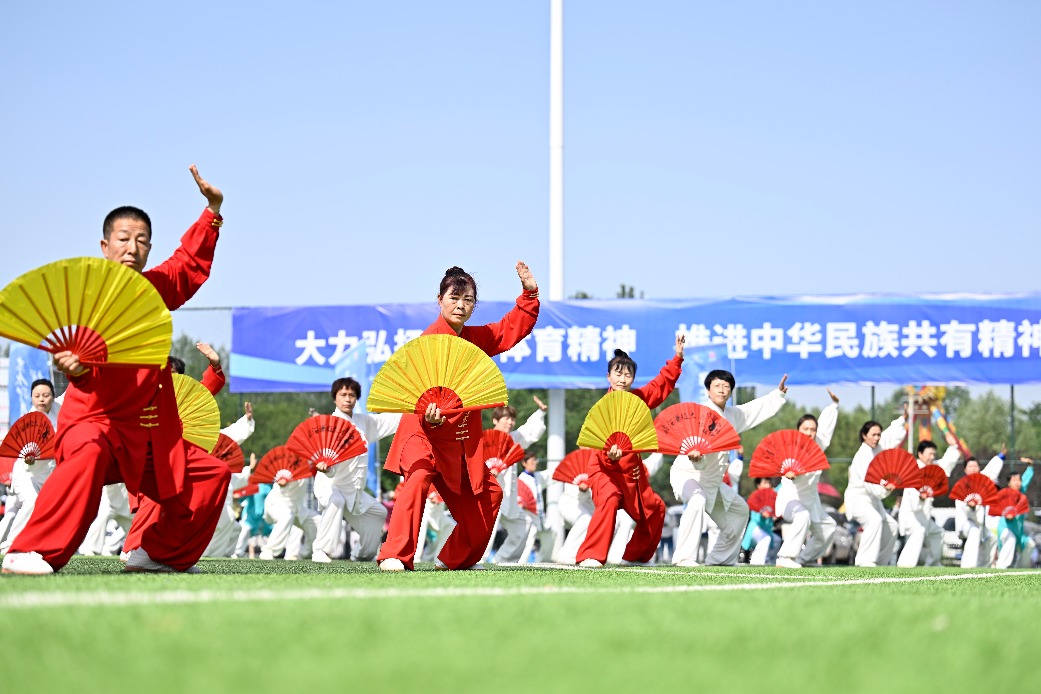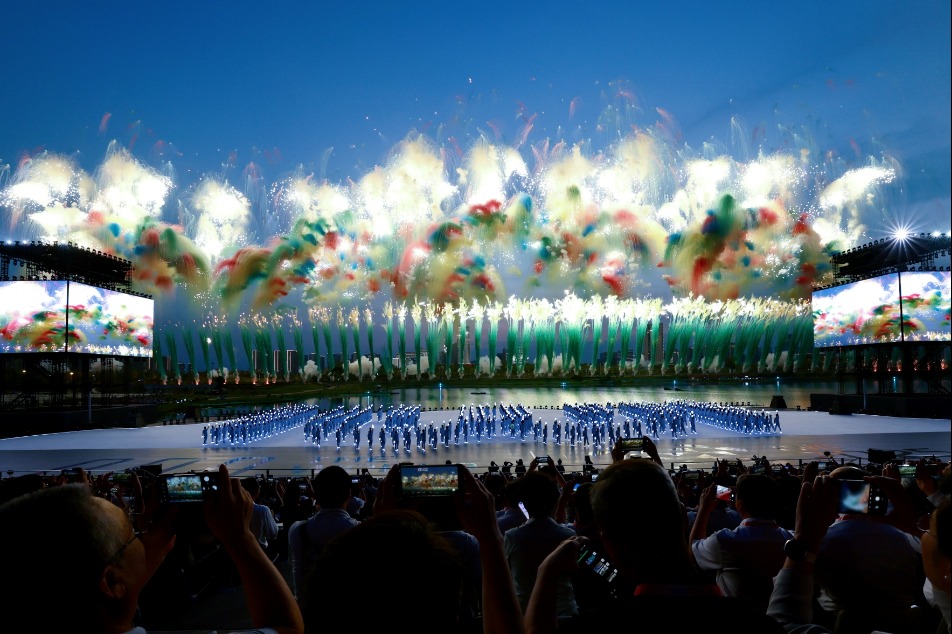A life between Africa and China

Sierra Leonean woman who followed her artist husband to Beijing says too few Africans really comprehend Chinese culture
Many Africans who go to China have little understanding of the country, even after having lived there for years, according to artist Ada Yang, who is from Sierra Leone.
Yang, 28, who lives in Beijing with her Chinese artist husband, says many Africans who have been in China for five or even 10 years don't really understand the country or its culture.
| Ada Yang plays a guqin while her husband, Yang Yan, explains calligraphy to their students. Provided to China Daily |
| The third Duyi International Cultlure Festival brought together artists and diplomats from 37 countries to introduce their unique cultures. Chen Yingqun / China Daily |
"Some people don't really have many opportunities or the passion to learn about Chinese people or culture when they study or work here, so when they talk about China to their families and friends back home, they are able to talk about only very shallow and incomplete things, such as the air here not being very good," She says.
Ada Yang and her husband, Yang Yan, a Chinese landscape painter, are trying to bridge the gap of understanding among people of different cultures. One of the ways is through the Queenmark Foundation, which she founded to pursue cultural and charity work.
Also, in June, she had just finished putting on the third Duyi International Culture Festival in Beijing, an event she and her husband started and support that brings together artists, diplomats and businesspeople from 37 countries to introduce their unique cultures in exhibitions, performances and fashion shows. Some countries' food, artwork and handicrafts were on display.
More than 2,000 people participated in the event in Gotrues, a compound in eastern Beijing that is home to many art exhibitions and galleries.
"I have been in China for years and have visited many places and many people. My husband is Chinese and a master in painting and traditional Chinese culture, so I have learned a lot," she says. "It is important for Chinese and African people to get to know each other better, and I want to create a platform for that."
Ada Yang also once knew little about her adoptive country. Her China story starts in 2011, when she was an economics major in her third year of college in Sierra Leone. She was introduced to Yang Yan by a friend. They soon fell for each other and Ada Yang followed him to China.
She says the only knowledge she had of China was through kung fu movies starring Hong Kong action star Jackie Chan, but she still followed Yang Yan to what seemed like his remote and mysterious homeland.
"There are huge differences between my country and China - language, culture and climate. But I know when you go to any place, you need to respect and follow what people do there. Day by day, I have just quickly gained an understanding of the people and culture of China," says Ada Yang, who now speaks fluent Chinese.
She spoke at her home in the Chinese capital, sitting beside a huge wooden desk on which rested a stack of rice paper and a container full of Chinese brushes. The rice paper is traditionally used for Chinese painting and calligraphy.
Ada Yang has become skilled in several traditional Chinese art forms, including Peking Opera, calligraphy and playing the seven-stringed guqin. While watching her husband paint, she picked up brushes and learned about traditional Chinese painting, done on rice paper or on silk, with a special brush, ink and paint made from mineral and vegetable pigments.
Her work is accomplished enough to have been exhibited at the National Museum of China.
Many of Ada Yang's works are paintings of mango trees - common in her hometown - using different colors and brushstrokes to show how they look at various stages of growth.
She and her husband have collaborated on some artwork, including a series of paintings of Marian plum trees, also called plum mango trees. On the treetops are blossoms, while on the trunks are fruit that look like miniature mangos. The series of work was sold to African embassies and Chinese museums.
The first Duyi festival was held in June 2013, and preparing for it was difficult, Yang says, as she lacked experience organizing a cross-cultural event and there also was a language barrier. She spent months and months with her friends and foundation volunteers working on it.
"But it feels very good to be able to see so many Chinese artists and African artists and people together," she says, adding that three cross-national couples first met at the festival.
Ada Yang says another of their projects is developing a park in Sierra Leone where they want to exhibit Chinese culture, such as Peking Opera, martial arts and paintings, to help her countrymen learn more about China. She also is working on putting together a space in China where she could display African artwork and fashions.
Yang Yan, who had traveled to more than 50 countries to perfect and promote his art before meeting his future wife, says her decisive, forthright and sincere personality has touched him deeply. He says he always will be supportive of her cultural exchange work. To keep the festival noncommercial, the couple says they underwrote its expenses, which ran to 300,000 yuan ($48,000) this year.
Yang Yan, who is from Qinghai province in Northeast China, one of the country's least-developed areas, says African culture has influenced his traditional Chinese painting. It is close to nature and pure, and people's relationship with nature is intimate, he says.
"The event not only helps thousands of people communicate in that way, but afterwards its influence continues. It is very meaningful," he says.
Aside from cultural promotion, another reason they set up the foundation is to benefit those in Africa and China who need help.
At the festival in June, they launched an effort to raise money to assist 1,000 children in Africa with their education.
During the Ebola outbreak that peaked last year, some of Ada Yang's friends died. She and her husband worked to gather funds and medical supplies worth $300,000 to send to the worst-hit countries in Africa, which included Sierra Leone. One of their events was held along with the Chinese People's Association for Friendship with Foreign Countries, one of China's three major foreign affairs organizations.
"My mother always loves to help people, and I also want to be helpful," Ada Yang says. Her foundation now has more than 50 volunteers in China, hailing from Europe, Africa the United States and China.
She says most of the foundation's funds have come from auctions and sales of the couple's paintings, with most of the money going to schools for disabled children whose parents are migrant workers working in Beijing and surrounding areas.
In the spirit of getting more people involved in helping, they are working on a small-scale program that will enlist college students to collect used materials to donate to children in suburban Beijing whose parents are in prison, she says.
Ada Yang says the big changes in her life make her feel that she exists in a space situated between Africa and China.
"When I go back to my home country now, people often say that I have changed a lot," she says. "I have learned a lot in China, and I'm glad to change, and I hope when my friends back home see my changes they will also be influenced."
She says that in China, people are very serious and focused on their work. "In my home country, sometimes people don't think much about working efficiently and don't pay much attention to high quality. Some people don't respect culture and art. But I see many Chinese doing things in a very effective and organized way," she says. "If we could learn the way they do things and the way China has developed its economy, Africa would also be able to develop in a better way. "
chenyingqun@chinadaily.com.cn
(China Daily Africa Weekly 07/10/2015 page28)
Today's Top News
- Xi urges all-out rescue efforts following mountain torrents in Gansu
- A Quixotic quest to reindustrialize US
- Grassroots sports events promoting nation's fitness goals
- Major test brings lunar mission closer to reality
- China likely to continue buying gold
- World Games dazzle spectators in Chengdu
































